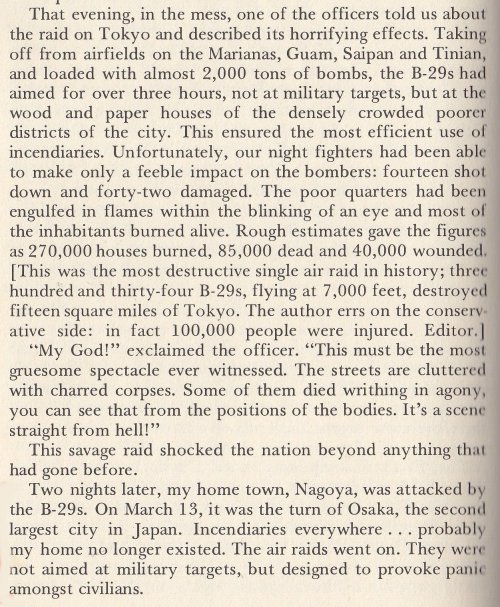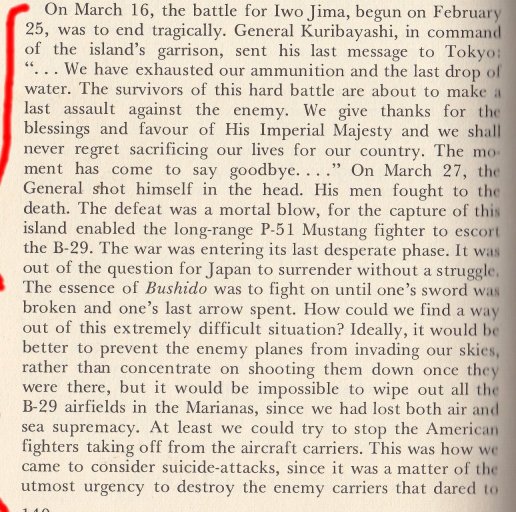
I Was a Kamikaze

This 1972 book is by Ryuji Nagatsuka who was a kamikaze in World War II. He lived through the experience because the war ended before he was actually involved in an attack on actual ships.
It's a fascinating book, obviously written by someone who, at the time, believed fully in the Emperor and was willing to die for his country by flying his plane into an American ship.
The book talks a lot about the training of the kamikaze and includes information on the problems they were having in getting fuel for their planes (sometimes they had to do nothing because they had no fuel for their planes at all), and in getting decent planes (they sometimes used bi-planes for training.) He also talks about the times he fought against the B-29's, and how big a problem those planes were for the Japanese.
The war ended before he had a chance to actually attack any ships, though. Problems with weather, lack of fuel, poorly performing planes and other matters caused various planned attacks to fall apart or never even begin.

This quote from the book shows what other books had said, but is from someone on the inside. The Japanese civilians were not told the truth about what was going on in the war when things started getting bad.

They pilots get told even more bad news.

Even more bad news.

This was their training schedule, from six in the morning until six at night. At this point, their training was in gliders; they hadn't even flown an airplane yet.

This was an idea of the military that helped doom their efforts. They believed that, if the soldiers simply had a strong enough will, they could overcome the American forces who happened to have more and better guns, planes and ships than did the Japanese. They also had failed to take into consideration that the Americans had the will to carry on; they would not crumple even if they lost a battle. The Americans just kept coming.
He talks about the fall of Saipan, and how many civilians and soldiers both had committed suicide. Then the attention of the trainee pilots was shifted onto the B-29, with the idea that they could perhaps ram the planes and destroy them that way since nothing else seemed to be very effective.
There was a major difference between flying school and regular military training, according to the author. The use of corporal punishment, like slapping and hitting trainees, was used very little in flying school but was used a lot in the other military areas.

One of the strangest military myths I have ever heard.
There is more than one time when, during his training and actual fighting times, nothing could be done because there was a complete lack of fuel. This happens numerous times during the course of the book.

There was also a change in the fuel used. He notes that some trainees died due to accidents caused by the poor-quality fuel.

A superior gave the author his own view of the fighting.
His first air battle was against the B-29s, but he didn't shot any down.
He mentions that the pilots were given relatively decent food, but the men taking care of the plans were given poorer food.

It was not only fuel that was short. In this case, an attack on B29s had to be ended because there was a shortage of ammunition.

He talks about the great firebombing raid on Tokyo in March of 1945.
He says that the Japanese lost control of the air, and control of the air was critical to winning the war.

Bushido is related to the war effort in this quote.

Technically, there was no such thing as a kamikaze; other terms were used.
In the Battle of the Philippines, 658 Japanese died in suicide attacks. The kamikaze attacks were, basically, the last thing left for the Japanese to use. They had no Navy left, basically. Their Armies had been defeated or bypassed or were stuck in China or still stationed in Japan. Their airplanes had been mauled by the U.S. Their weapons were nowhere near as good as American weapons, and that's when they actually had them. Pretty much the only way to stop the planes bombing Japan was to stop them before they were able to take off, and that meant sinking the carriers.
After the end of the war, he returned to Tokyo and saw the devastation left by the firebombing, and that shook him up quite a bit.
Main Index
Japan main page
Japanese-American Internment Camps index page
Japan and World War II index page
|